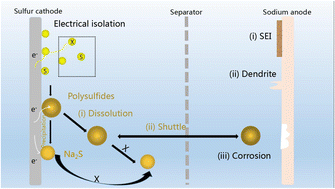Strategies to mitigate the shuttle effect in room temperature sodium–sulfur batteries: improving cathode materials
Abstract
Room-temperature sodium–sulfur batteries (RT-Na/S batteries) with high reversible capacity (1675 mA h g−1) and excellent energy density (1274 W h kg−1) based on abundant resources of the metal Na have become a research hotspot recently. However, the intermediate product sodium polysulfides (NaPSs) generated during the charge–discharge process are easily dissolved in the ether electrolyte and transferred from the sulfur cathode to the metallic sodium surface, resulting in rapid capacity decay (shuttle effect), which seriously affects the practical application of RT-Na/S batteries. Herein, the mechanism and recent research progress in suppressing the shuttle effect of the sulfur cathode in RT-Na/S batteries are summarized. Strategies such as carbon-based materials physically fixing NaPSs, polar materials absorbing NaPSs to reduce their dissolution, and catalytic materials accelerating the transformation of NaPSs into final products are provided. Challenges and insights into high-performance sulfur electrodes for optimizing RT-Na/S batteries are discussed.

- This article is part of the themed collection: 2023 Frontier and Perspective articles


 Please wait while we load your content...
Please wait while we load your content...